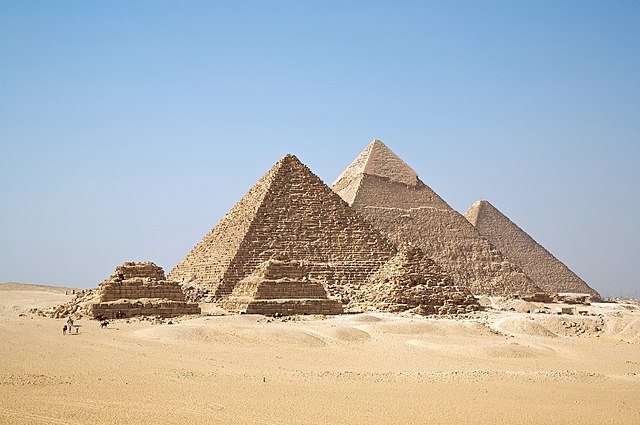19. Ancient Mesopotamia and Egypt (~3200 – 539 BCE)
Summary In the fertile lands of Mesopotamia and Egypt the first known states and urban civilizations evolved at the end of the 4th millennium BCE. In these states scribes invented writing in order to keep track over the resources, debts and duties of their subjects; blacksmiths created bronze tools; and huge monuments such as the Pyramid of Cheops were erected. Several powerful states rose and fell in that region in the next 2500 years, such as the Old, the Middle and the New Kingdoms in Egypt, and the Akkadian, the Babylonian and the Neo-Assyrian Empires in Mesopotamia.
Keywords History of Southwest Asia; Technology; Writing

The Fertile Crescent in southwest Asia. In a broader definition it stretches from Mesopotamia (today’s Iraq) in the southeast via Syria in the north to Egypt in the southwest. (© User:Nafsadh / Wikimedia Commons / CC-BY-SA-4.0)
Several important events in the early history of humankind took place in the Fertile Crescent. This was the first place where the Agricultural Revolution had unfolded since about 10,000 BCE. In a broader definition the Fertile Crescent stretches from Mesopotamia (today’s Iraq) in the southeast via Syria in the north to Egypt in the southwest. As in the Fertile Crescent the earliest known states and urban civilizations evolved, it is also called the “cradle of civilization”. These states and civilizations are the first known ones, as writing itself evolved in that region around 3200 BCE.
Writing evolved in Mesopotamia and in Egypt, with the Mesopotamian writing system being called cuneiform and the Egyptian one being known as the Egyptians hieroglyphs. The first texts were not novels or religious texts but rather served the states in this region to keep track of resources, debts and duties of their subjects. Both writing systems predate the first full scripts in China of 1200 BCE and in Central America of 1000-500 BCE. While cuneiform and the Egyptian hieroglyphs were used for more than three millennia in their respective regions, they were forgotten in medieval times and again deciphered by European scholars in the 19th century.
One important working material in that time was bronze, being an alloy of copper and tin, which could be used to create tools and artefacts since about 3300 BCE. As bronze is harder and more durable than other useable materials of that time, bronze tools gave crucial advantages to their users. The following time was such called the Bronze Age, which followed on the previous Stone Age. Developments which had preceded this technique were improvements in pottery and in machining of copper. Other important inventions of that time were the inventions of the wheel and of the sail in the 4th millennium BCE and of glass in the 3rd millennium BCE.

The pyramids of Giza, Egypt. The tallest of it, the Pyramid of Cheops, was constructed in the 26th century BCE and was the tallest man-made structure from the time of its construction until the 14th century CE. (© Photographed by Ricardo Liberato / Wikimedia Commons / CC-BY-SA-2.0)
Egypt, the narrow stripe of fertile land along the Nile which meanders through the Sahara desert in northeast Africa, was for the first time unified around 3150 BCE. During the Old Kingdom (2686-2181 BCE) the largest pyramids were built and an early peak of the Egyptian civilization was reached. The pyramids were usually tombs for pharaohs, the Egyptian rulers, and they were covered by a white reflective limestone surface in the past. The Pyramid of Cheops (also called the Pyramid of Khufu) was constructed in the 26th century BCE and was, at a height of nearly 150 meters, the tallest man-made structure from the time of its construction until the 14th century CE, that corresponds to about 75% of the time since the invention of writing. Over the course of history Egypt would split up and be unified again in the Middle Kingdom (2055-1650 BCE) and the New Kingdom (1550-1069 BCE).
In Mesopotamia, along the Tigris and the Euphrates in the eastern part of the Fertile Crescent, the Sumerian civilization thrived from the 4th millennium BCE to around 2000 BCE, being centered around early cities like Uruk, Ur, Lagash and Nippur. The first empire in this region, ruling over around a million subjects, was founded by Sargon of Akkad and was known as the Akkadian Empire (about 2334-2154 BCE). In the following millennium Mesopotamia was usually dominated by the Babylonian Empire under the Amorite dynasty (about 1830-1531 BCE) and the Kassite dynasty (about 1531-1155 BCE).
The Bronze Age Collapse of about 1200 to 900 BCE represented a Dark Age for the Fertile Crescent, as states, trade and literacy declined. Part of the reason for this decline were invasions of Indo-European peoples which originated from Central Asia. Around 1200 BCE the Bronze Age was superseded by the Iron Age, as now furnaces could produce high enough temperatures to machine iron. Also the earliest known alphabet – being a new type of writing system if compared to logographic systems such as the Egyptian hieroglyphs or Chinese characters – was used by the Phoenicians at the eastern Mediterranean shore around that time. Virtually all modern alphabets were derived from the Phoenician alphabet, including the Greek, the Roman, the Cyrillic, the Arabic and the Hebrew alphabets.
Prosperous states in the Fertile Crescent revived after the Bronze Age Collapse. These were in particular the Neo-Assyrian Empire (911-609 BCE), which ruled over both Mesopotamia and Egypt for the first time, and later the Neo-Babylonian Empire (626-539 BCE). In the 7th century BCE the Kingdom of Lydia in Asia Minor started to produce standardized coins made of gold, silver or bronze as money, from which all modern coins descend. The independent history of Mesopotamia and Egypt ended with the conquest by the Persian Achaemenid Empire in 539 BCE and 525 BCE, respectively.
